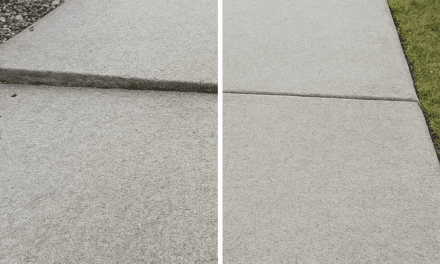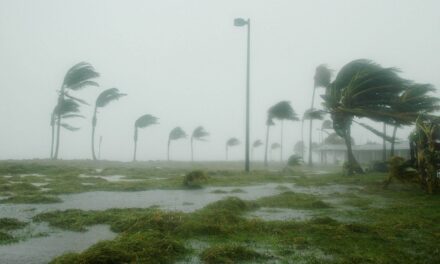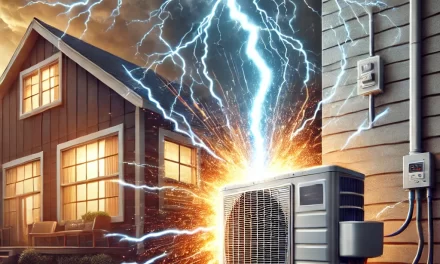Last updated on December 5th, 2025 at 08:03 am
Be aware that your homeowners’ insurance company will be inspecting your house before or just after renewal. One day, your insurance agent may call and tell you that your policy will be suspended because of trees overhanging your house. Tree branches and limbs that overhang insured structures create an undesirable risk for homeowners’ insurance companies.
You could also receive this notice: “Please have tree limbs and branches trimmed back so that they do not touch or overhang the insured dwelling/roof, otherwise a roof exclusion may be applied.” I know, this happened to an investment property that I own. While they were not going to cancel the entire policy, excluding the roof coverage in a high-wind area is almost the same thing.
Comming soon
An extraordinary story about trees falling on a house, check back for this story or sign-up to receive notice of new articles
What is worse is if those trees overhang power lines on your property. A combination of overhangs on your roof and power lines is a disaster waiting to happen. Get those trees trimmed.
A popular question is what distance from the house is the tree required by insurance companies? It’s not the distance from the house to the trunk. Insurance companies do not want anything overhanging your house. You can cut branches exactly even with the roof line, and that can work. Imagine looking down on your roof from Google Earth or from a drone. You will want to see the entire roof with no branches overhanging.
Some trees grow branches at a rapid pace; in one season, branches removed last year can come back without attention. Check out our tree age calculator at the end of this article.
Many of my clients, and even at my own properties, insurance companies have demanded that trees be trimmed. Often, this is no small job. Some trees grow to 80′ and many have large spreads. Insurance companies looking to eliminate risk have been hiring more inspectors than ever before.

Remove tree limbs from your home and building
With all of the hurricanes, tornadoes, and weather events, it’s a good idea to make sure that your covered structure is in fact, not covered by trees. Just when you thought that your trees were clear off your roof, you noticed your neighbor’s tree hanging over your garage.
Any trees overhanging a covered structure cause issues with insurance providers. If the tree is on your neighbor’s property that overhangs your covered property, have the portion on your property trimmed? Be sure to check with local rules on this and consult your neighbor.
There are local and state laws about how to handle specific situations. This is not rocket science; if you can see branches overhanging with the naked eye, they need to be trimmed.
You will also want to take a look at the health of your trees. If you have diseased trees, remove them before they fall. A falling tree can create tremendous damage to your house. A family member recently suffered a loss when, during a tornado, a very large tree fell on the house. Large trees can do great damage, as in the case of my family member.

Your insurance may not cover damage from trees
Insurance claims can be filed and will probably be paid, but as with any claim against insurance, they will want to know if the tree was already damaged. Did it overhang the house, etc? This information could affect your recovery. They want to know the true cause of the tree falling and not just the wind.
If you believe you have time, trim your trees in the fall and early spring when leaves are off the trees (for trees that shed leaves). Avoid cutting healthy trees on very hot days. Tree care is your responsibility, according to insurance companies. Most homeowners’ insurance will not cover tree removal unless it was damaged in a storm. Read this from Farmers Insurance
Trees add value to your home if they are properly cared for. The best way to ensure that your trees complement your home is to routinely trim them and feed trees to prevent the trees’ roots from being damaged. While you are looking for branches over your house and other structures, do not forget the roots.
I have seen large roots from oak trees actually lift sidewalks and concrete foundations. Don’t let it get that bad. At first sight of a root pushing up concrete, contact a certified arborist or cut the offending root back.
Your homeowners insurance company may be using drones to inspect your roof
Cut those trees, drones are out there without any notice
It’s not just falling limbs; those roots can be a problem
You can also place root barriers in places where you want to prevent roots from causing damage. Roots will seek water and nutrients, so deny them both. Root barriers made of plastic or metal are usually sufficient. Insurance companies will rarely ever compensate for root damage. Structural damage caused by roots is considered the homeowner’s responsibility.
Another issue is roots causing damage to the sewer and water systems. Root systems can grow very large underground and have serious side effects, such as breaking your sewer line.
One of my clients recently went through this process. The slab had to be broken in order to find the place where the roots were damaging the sewer. It was an expensive problem. One way to prevent root damage is to plant trees well away from the house. The various types of trees have different root systems, and some are better to plant near buildings than others. If you have a root problem, call a professional contractor to deal with it.
Most homeowners’ insurance policies include coverage for tree removal, but only when the tree causes damage as a result of a storm or another covered event. The keyword here is “covered.” If a tree falls without damaging any property, most insurers won’t cover the cost of removal.
Additionally, if the tree was already dead or in poor condition before it fell and caused damage, your claim could be denied. Because each policy is different, it’s not possible to provide a definitive answer about coverage within this article.
Property owners should regularly inspect trees, particularly if lightning strikes a tree. If your tree is dead, even if it can not reach the roof, remove it before it causes another tree to fall or fall on a neighbor’s fence.

What happens if a tree falls on your house?
The following is a recap of an article published on the Insurance Policy Institute website. Please note that while your insurance may “cover” losses, the amounts they pay can be insignificant compared to the cost of tree removal and repairs. Then there are deductibles.
- Coverage for Falling Trees: Standard homeowners insurance typically covers damage to your home or other insured structures (like a detached garage) if a tree falls due to wind, lightning, or hail. This includes damage to the structure and its contents.III+5III+5Insurance Industry Blog+5
- Ownership of the Tree: It doesn’t matter who owns the tree. If a neighbor’s tree falls on your house, your insurance should cover the damage. Your insurer may seek reimbursement from the neighbor’s insurance if negligence is involved, potentially refunding your deductible.III+1Insurance Industry Blog+1
- Tree Removal Costs: If a tree damages an insured structure, your policy may cover tree removal costs, generally up to $500 to $1,000, depending on your insurer and policy type. If the tree doesn’t hit a structure, removal isn’t typically covered unless it blocks a driveway or a handicap-accessible ramp.III+4III+4III+4
- Damage to Trees and Shrubs: Homeowners’ insurance may cover damage to trees and shrubs caused by specific perils like fire, lightning, explosion, theft, aircraft, vehicles not owned by the resident, vandalism, and malicious mischief. Coverage is usually limited to 5% of the dwelling coverage amount, with a cap per tree or shrub.
- Maintenance Matters: Damage resulting from poor maintenance, such as neglecting dead or diseased trees, is not covered. Regular upkeep is essential to ensure coverage eligibility.
For more detailed information, you can read the full article on the Insurance Information Institute’s website: III.
Trim trees and take photos for insurance
Take photos of your house after trees are trimmed as proof in the event of a weather-related incident. Show the photos to an insurance adjuster if necessary. They should be dated. Be sure that trees are a covered peril. One of the biggest costs of repairing homes after a major weather event, such as a hurricane, is fallen trees. Have your handyman trim your trees during the best time of year in your area.
The property damage from the insured structure may be covered, but it gets complicated when trees are involved. Removing fallen trees is a big cost, and you must pay the deductible on any claims you make. Healthy trees are not usually felled by strong winds. Dead trees can fall at any time.
The good news is that you can often trim trees with the use of a pole saw. A pole saw with an 8″-10″ chain can cut some larger limbs. If you decide to trim your own tree, always have the assistance of another person. Be careful of power lines. If you stand on your roof, be sure you are secure.
Read our extensive article on trimming/pruning trees and the tools required by clicking here.
Consider whether it is best to hire a tree trimmer
The potential danger of falling may outweigh doing the trimming yourself. Recently, I was inspecting some of my properties and noticed lots of branches at head height blocking the entrance. I cut most with clippers and a pole saw without using a ladder. Your handyman may be able to trim your trees.
I received a notice from the insurance company that trees hanging over a rental property must be trimmed or the policy will exclude the roof. It’s interesting how, before you know it, trees have grown much larger. I should have trimmed them before they got as high. A couple of the trees had reached 60′, so a professional was called out. They use a large lift that extends 50′ to get high enough.
Real Estate Agents – Trees
Real estate agents have a responsibility to their buyer clients to identify and address potential issues related to trees, particularly overhanging limbs. Insurance companies often view overhanging limbs negatively, recognizing them as a potential risk for damage to the property. This can lead to increased premiums or even difficulty obtaining coverage. Therefore, it’s crucial to bring this issue to the client’s attention *before* they purchase the home.
Addressing overhanging limbs proactively can save your clients significant money and hassle. Imagine your clients moving into their new home only to be faced with the unexpected expense of tree removal. This can easily cost hundreds or even thousands of dollars. By addressing the issue upfront, you can help them avoid this unpleasant surprise.
Here are two effective strategies to handle overhanging limbs:
- Request Removal Before Closing: The ideal solution is to request that the sellers have the overhanging tree limbs professionally removed before the real estate closing. This way, the issue is resolved before your clients take ownership of the property.
- Secure Funds for Removal at Closing: If the sellers are unwilling to remove the limbs before closing, negotiate for them to obtain a professional estimate for the removal cost. Then, request that these funds be held in escrow or provided as a credit to the buyer at closing. This allows your clients to arrange for the removal immediately after closing, using the funds provided by the seller.
By taking these proactive steps, you demonstrate your commitment to your clients’ best interests and help them make informed decisions about their real estate purchase. Addressing the issue of overhanging limbs not only protects their financial investment but also ensures a smoother and more positive home buying experience.
Tree trimming can be expensive if you let the trees get out of control
On this particular house, there was a branch about 7″ wide overhanging the house and the power line. It took great skill to cut the branch and lift it so that it would not hit the roof or take down the power line. I was lucky, the people cutting my trees gave me a very good price, but still, it was several thousand dollars.
The best practices are to trim the lighter branches you can safely reach and hire a great service to cut trees out of reach. While you are trimming/pruning branches, consider trimming lower branches that grow from the ground or below head height from the trunk. Keep the trunk clean of these branches, which will eventually become much larger obstacles.
Be aware that some trees may be protected. In Mississippi, live oaks and magnolia trees greater than a specified width are protected by law. You always have the option to remove parts of these trees that overhang your house, but taking down major limbs in other areas may require a permit.
What does it cost to trim trees overhanging a house?
Expensive. I hear all the time from clients and others who are looking for the “deal” when it comes to trimming trees. Trees over a single-story house can sometimes be removed without special equipment. On two-story houses, this becomes more difficult. I recently had trees cut around my two-storey duplex. The contractor had to bring in a scissor lift to get up more than 30′.
The following are the factors that are used to calculate the cost of tree trimming and branch removal:
1. Tree Size and Species:
- Height: Taller trees require more labor, specialized equipment (like cranes), and increase the risk factor, all of which drive up the cost.
- Diameter: A thicker trunk means more wood to cut and remove, increasing labor and potentially requiring heavier equipment.
- Species: Some trees have denser wood, complex branching, or extensive root systems, making them more challenging and time-consuming to remove.
2. Tree Location and Accessibility:
- Proximity to House: Trees directly over or very close to a house require extra care to avoid damage. This often means using specialized rigging, cranes, or even dismantling the tree piece by piece, significantly increasing the cost.
- Accessibility: If the tree is difficult to access (e.g., fenced yard, steep slope, limited space), it may require specialized equipment or more labor to get the tree down safely, adding to the cost.
3. Tree Condition:
- Health: Dead or diseased trees are often more brittle and unpredictable, making them more dangerous and time-consuming to remove, thus increasing the cost.
- Structural Issues: Trees with leans, cracks, or weak branches require extra care and specialized techniques to prevent accidents, which can add to the expense.
4. Complexity of the Job:
- Obstacles: Power lines, other structures, or nearby trees can complicate the removal process and necessitate extra precautions, increasing the cost.
- Branching: Trees with many large branches or complex canopies require more time and effort to dismantle safely, affecting the price.
5. Additional Services:
- Debris Removal: Hauling away branches, logs, and other debris can be included in the service, but may also be an additional charge.
- Stump Grinding/Removal: If you want the stump removed, this is typically a separate service with its own cost.
- Permits: Some areas require permits for tree removal, and obtaining these can add to the overall cost.
6. Labor and Equipment:
- Crew Size: Larger trees or complex removals require more workers, increasing labor costs.
- Equipment: Specialized equipment like cranes, bucket trucks, or heavy-duty chippers may be necessary, and the cost of renting or using this equipment will be factored into the price.
7. Location and Market Rates:
- Geographic Location: Tree removal costs can vary depending on where you live due to differences in labor costs, insurance requirements, and local regulations.
- Demand: High demand for tree removal services in your area may also drive up prices.
The average cost to cut and remove branches can be anywhere from $500 for a single-story house with no large equipment used to $4,000 and sometimes more, based on the above. The cost is almost always shocking to the property owner. In addition to the professional I hired to trim trees at my duplex, my nephew and I trimmed a very large pecan tree at another property that I own.
Fortunately, the house was a single story, and the roof pitch was almost flat. With our 8′ long electric tree trimmer, we were able to get to all of the branches above the house. We found that cutting up all of the branches was a chore. Since that was pecan wood, which many use for BBQs, we left it out in front of the house, and it was taken.
Stumps are another issue
If the roots of a tree must be removed along with the stump, it can cost hundreds of dollars and disturb the yard and possibly the foundation of your house. It may be best to grind the stump to just below the surface and leave the roots in place. Consult your tree trimming service about what’s best.
In some wetland areas, you may be required to leave the roots in place to hold the soil. This may be true even for other homes that are on a downgrade.
Protected trees require permits for some trimming
Protected trees often require licensed tree services to follow a permit that is issued to trim specific parts. The intent is not to harm a healthy tree. Even if your protected tree appears to be dead, call a professional for their opinion. You may still require a permit even to remove a dead tree.
If the tree is cut at ground level, you can hire a company with a stump grinding machine to remove it. This often occurs when the dead tree must be removed, but the root system could damage the property if the root is pulled up. Trees in some wetland areas may not be completely removed but instead cut near the ground to leave the root system in place. Root systems from trees that were removed help to bind the soil.

Information about trees
While all trees have roots, some species are known for their aggressive, invasive root systems that can cause significant damage to property. Here are a few examples:
- Poplars: These trees have shallow, fast-growing roots that can spread widely and damage foundations, sewer lines, and sidewalks.
- Oaks: Many oak species, especially those with large, spreading canopies, have strong, deep roots that can also cause foundation damage.
- Maples: Some maple trees, like the Norway maple, have invasive roots that can disrupt sidewalks, driveways, and sewer systems.
- Elms: American elms, in particular, have moisture-loving roots that can search for water sources, often leading them to invade sewer lines and foundation cracks.
- Willow: Willows have shallow, fibrous roots that can spread rapidly and cause damage to underground pipes and structures.

Trees with shallow or weak root systems are particularly susceptible to falling in high winds or extreme weather events.
Here are some common species that often fall:
- Poplars: Known for their shallow, spreading roots, poplars are prone to toppling in storms.
- Willows: These trees also have shallow, fibrous root systems that provide poor anchorage.
- Red Maples: Red maples can develop weak or shallow roots, especially in poor soil conditions.
- Cottonwoods: Similar to poplars, cottonwoods have shallow roots that make them vulnerable to wind damage.
- Ashes: While many ash species have strong root systems, some, like green ash, can develop weak or shallow roots in certain conditions.
Other factors that can increase a tree’s risk of falling include:
- Age: Older trees may have weakened root systems or structural defects.
- Disease or pests: Trees weakened by disease or pests are more likely to fall.
- Soil conditions: Poor soil drainage or compaction can compromise a tree’s root system.
- Location: Trees planted in exposed areas or near structures are at higher risk.
Trees that are particularly sensitive to root damage include:
- Maples: Many maple species, especially sugar maples, are susceptible to decline or death if their roots are significantly damaged.
- Oaks: Oaks, especially live oaks and white oaks, can be sensitive to root disturbance, especially if the damage is extensive.
- Elms: American elms can be vulnerable to root rot and other diseases if their roots are damaged.
- Pines: Some pine species, such as loblolly pines and longleaf pines, can experience stress or decline if their roots are cut.
- Fruit trees: Apple, peach, and other fruit trees can be sensitive to root damage, which can affect their productivity and longevity.
Factors that can influence a tree’s susceptibility to root damage include:
- Tree species: Some species are naturally more tolerant of root damage than others.
- Age and size: Younger, smaller trees may be more resilient to root damage than older, larger trees.
- Soil conditions: Trees growing in poor soil or compacted soil may be more vulnerable to root damage.
- Extent of root damage: The amount and location of root damage can affect a tree’s ability to recover.
Best Time to Trim Trees
- Deciduous Trees: Late winter to early spring (February – April) for healthy regrowth.
- Evergreen Trees: Late winter to early spring to maintain shape and health.
- Spring-Flowering Trees: Right after blooming in spring to avoid removing buds.
- Summer-Flowering Trees: Late winter or early spring to encourage new blooms.
- Dead or Diseased Branches: Can be removed anytime for tree health.
- Oak Trees: Trim in winter (December–February) to prevent oak wilt disease.
- Maple & Birch Trees: Trim in late summer or early fall to reduce excessive sap bleeding.
Trees can damage fences
The last topic is about damage caused by trees to fences. First, is it your fence or your neighbor’s? If it’s your neighbor’s fence and your tree, who covers it? If your neighbor’s tree falls on your fence, which insurance company deals with it? Check out this good article about this topic.

Cleaning up trees for visual improvement
I see that many people ignore or do not observe that small trees and branches are growing from the roots of trees. With my 82 trees, I am constantly watching for this, and it happens with regularity. Often the pine trees will become a good spot for hardwood trees to grow saplings a the roots.
Cut them all off. Clean up your trees and keep them trimmed when a branch is in a bad place. Trees as part of landscaping should have a clean appearance. Energy is diverted from the tree to support those new growth stems; removing them keeps the tree growing properly.
If you see a branch growing over your driveway, trim it before it becomes a job for a professional. For newly planted trees, guide your tree’s growth by pruning on a regular basis.
I bought a 1930s house to use as an office in Gulfport, MS. There is a live oak about 100 years old growing over the entrance of the driveway. A branch over 1′ in diameter hangs just 3′ higher than the top of my pick-up truck. The owners of the house should have trimmed the tree in about 1940 or 1950 to prevent the branch from growing so low. That ship has sailed now. Good thing, I would not want to remove it, the tree is so majestic.
Landscaping will improve curb appeal, and your insurance inspector will be pleased
Try planting shrubs around your home, away from the house, a little to prevent water from penetrating under the house. Some shrubs that can become very large and fill in space left by removing a tree are Azaleas and Camellias. You can’t grow these beautiful plants in all climate zones. There are similar plants available in your climate zone. Keep your insurance inspector pleased with how well you are taking care of your house.
Have you ever considered starting a business or starting a business after retirement? Landscaping and tree trimming are great businesses to start. Landscaping does not require a large investment up front, and word of mouth is a good way to get started. Check out our series on Starting a Business After Retirement and learn what it may take to get your new landscaping business going.
Real Estate Agents should understand the information included here. Helping their sellers to by recommending they trim trees ahead of listing the property will help.
Trees to Avoid Near Foundations
Planting trees on your property. Check out our list of trees to never plant near a foundation, as they have root systems that move laterally underground and can destroy concrete. Safer trees to plant near your house are listed at the end of this section.
1. Willow Trees (Salix spp.)
- Why: Extremely aggressive root systems that seek out water—can crack foundations, invade sewer lines, and lift sidewalks.
- Common types to avoid are weeping willow and black willow.
2. Silver Maple (Acer saccharinum)
- Why: Grows fast, but has shallow, wide-spreading roots that damage foundations and plumbing.
- Extra issue: Brittle limbs that easily break in storms.
3. American Elm (Ulmus americana)
- Why: Large size and aggressive roots—they’ve been known to buckle sidewalks and disrupt pipes.
4. Poplar Trees (Populus spp.)
- Why: Especially Lombardy poplar—fast-growing with very invasive roots. These roots can travel far and lift concrete.
5. Eucalyptus
- Why: Fast-growing, thirsty, and potentially unstable in the wind. Roots can become invasive, especially in warm climates.
6. Oak Trees (Certain Types)
- Why: Not all oaks are bad, but large species like Northern Red Oak or Southern Live Oak develop extensive root systems that can stretch far from the trunk and disrupt foundations.
7. Black Locust (Robinia pseudoacacia)
- Why: Aggressive spreading, invasive in some areas, and sends out suckers from its roots, which can cause damage over time.
✅ Safer Tree Choices Near Homes
If you want something close to the house, consider:
- Dogwood (Cornus florida)
- Japanese Maple
- Serviceberry (Amelanchier)
- Crabapple (Malus spp.)
- Redbud (Cercis canadensis)
These are generally smaller trees with non-invasive roots—just give at least 10-15 feet of spacing from the foundation.

Click on the question below and see the answer
Frequently Asked Questions
1. Why does my insurance company care about tree trimming?
Overgrown trees pose a risk of falling branches or entire trees damaging property, leading to insurance claims.
2. Can my homeowners insurance be canceled for not trimming trees?
Yes, if your insurer deems your trees a hazard, they can issue a warning or cancel your policy.
3. How often should I trim my trees?
Most experts recommend trimming trees every 3–5 years, depending on species and growth rate.
4. Will insurance pay for tree trimming?
Typically, no. Tree maintenance is the homeowner’s responsibility unless trimming is needed after a covered peril.
5. What happens if a tree falls and damages my home?
If the tree falls due to a storm or covered event, your insurance may pay for repairs minus your deductible.
6. Are there signs that my trees need trimming?
Yes, signs include dead branches, overhanging limbs, and proximity to power lines or your home.
7. Can I trim the trees myself?
Yes, but hiring a professional is safer, especially for large trees or those near power lines.
8. How much does tree trimming cost?
Costs vary but range from $250 to $1,500 depending on tree size and location.
9. What should I do if my neighbor’s tree is a threat?
Notify them in writing and document concerns. If damage occurs, their insurance may be liable.
10. Will my premium go down if I trim my trees?
Not usually, but maintaining trees can prevent premium increases due to claims.
11. Do insurance companies require proof of tree maintenance?
Sometimes, especially after an inspection. Keeping records and photos is recommended.
12. Does insurance cover damage from a neighbor’s tree?
Generally, your policy covers damage to your home, but you may be able to claim against their insurance.
13. Are all tree species equally risky?
No, some trees are more prone to breaking or falling, like willows and pines.
14. What should I do if my insurer requires tree trimming?
Act quickly to comply. If you disagree, consult an arborist or insurance agent.
15. Will insurance cover damage from a tree I neglected?
If neglect caused the tree to fall, your insurer may deny coverage due to lack of maintenance.
What if my insurance is dropped or the roof is excluded?
First, address the notification immediately. Tell them you are working on the issue. Get the work done and send photos, etc., to the insurance inspector. Be sure they received them and that they have closed the case. Do not assume that because you sent the required information, the case was closed in your favor.
Should you receive an actual notice of non-renewal or cancellation, there may be some actions you can take to restore coverage. Read this article from Bankrate: What to do if you are dropped from your home insurance. You may need to notify your mortgage company that you are working on restoring the policy, or they will order one for you at your cost.
You must pay attention to any notification from your insurance company or mortgage company. Trust me, I have received a number of them over the years. Sometimes you get caught in the machine, and it’s hard to fix the issues.
If you have issues with your insurance company that you are working through, and they have notified you of an exclusion or cancellation, they have also notified your mortgage company. Contact the mortgage company immediately and tell them you are working on it. If you have a mortgage, you will be compelled to have full coverage on your house. Get ahead of the situation.
Thinking About a Tree Trimming Business After Retirement?
If you live in an area with plenty of mature trees, tree trimming can be more than just a seasonal chore—it can be a profitable business opportunity after retirement. Like lawn care, tree trimming has relatively modest startup costs compared to many other businesses. A quality chainsaw, pruning tools, safety gear, and possibly a trailer for hauling debris may be all you need to get started.
Keep in mind that this line of work does require some skill and experience, particularly when dealing with larger trees or branches near structures or power lines. In some regions, a license or certification may be required for insurance and legal compliance. If you already have landscaping or yard maintenance experience, adding tree trimming could be a natural business expansion—or a standalone service.
In neighborhoods where trees are abundant, demand can be steady year-round, especially from homeowners looking to maintain their insurance coverage. For retirees seeking an active, outdoor business with flexible hours, tree trimming can be an easier path into entrepreneurship than many other industries.
This article is part of our Starting a Business After Retirement series, where we explore practical, profitable, and rewarding business ideas for your next chapter.
Check out our free tree growth calculator below. Determine how old your tree is. It may be older than you.
Tree Age Calculator
For best accuracy, measure the tree trunk at 4.5 feet (1.37 meters) above the ground.
Professional Organizations and Websites
• International Society of Arboriculture (ISA)
– Offers certification, training, research updates, and a wealth of technical resources for professional arborists.
[Visit ISA Websiteen.wikipedia.org]
• Arbor Day Foundation
– Provides practical tree care tips, educational materials, and resources on tree planting, maintenance, and the benefits of trees.
[Visit Arbor Day Foundation arborday.org]
• Tree Care Industry Association (TCIA)
– Develops industry standards (such as ANSI A300) and offers guidelines on safe, effective tree maintenance practices.
[Visit TCIA Website (search for TCIA resources)]
inter• American Forests
– An organization focused on forest conservation that offers research and practical guides on tree management and care.
[Visit American Forests' Website (search for American Forests tree care)]
Government and Educational Resources
• USDA Forest Service – Tree Owner’s Manual
– A comprehensive guide to tree planting, care, maintenance, and safety considerations developed by the USDA Forest Service.
[Download the Tree Owner’s Manual fs.usda.gov]
• University Cooperative Extension Services
– Many universities (such as Michigan State University, Cornell, and the University of Minnesota) publish research-based guides and fact sheets on tree care, including topics on pruning, fertilization, and disease management.
– For example, check out Michigan State University Extension for regional tree care advice.
Books and Publications
• "Arboriculture: Care of Trees, Shrubs, and Vines in the Landscape" by Richard W. Harris
– A well-regarded textbook that covers fundamental principles, techniques, and case studies in tree care and maintenance.
• "The Tree Doctor" by John Davey
– A classic reference that discusses tree biology and proper tree care practices.
Additional Online Resources
• TreesAreGood.org
– An educational site provided by ISA with articles, videos, and tips on various aspects of tree care.
Articles from RetireCoast.com
If you enjoyed this article, please read our article about lawns here. You may also want to read our article about garden clubs here. We periodically post similar articles. With about 200 articles on this blog, there are others that you will find interesting.
Please leave comments, and tell us what you think of this and other articles. Subscribe above to receive notifications of new articles.
Discover more from RetireCoast.com
Subscribe to get the latest posts sent to your email.









